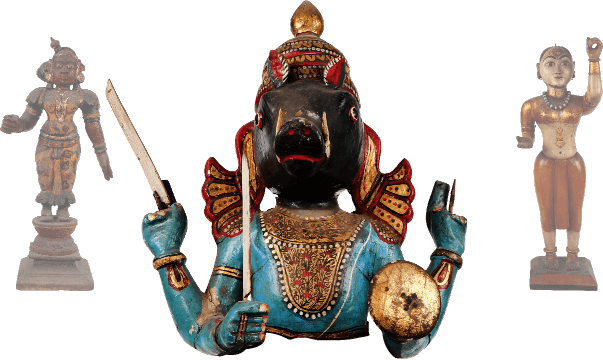Title : Figurine depicting Laksmi Sara
Accession No : 53/7/113
This is round disc representing Lakshmi Sara, with pink background and red border. On the top of the rim Vishnu and Lakshmi can be seen. Vishnu is standing in tribhanga posture, wearing a yellow dhoti, blue skin colour adorned with jewels, whereas next to him is Lakshmi wearing a red saree. Below them is seen Lakshmi standing flanked by two attendants on both side and also two peacocks with huge feathers.
Gallery
Provenance
- StateWest Bengal
Condition
- ConditionAverage
- Action NoteCR; Flaking, Accumulation of Dust
Dimensions
- Measurement (CMS)32 (dia)
- Weight (GRMS)0.00
Significance
- ReligiousThe Saras (ritual terracotta shallow plates) are made thrice a year, especially during the time of Durga and Lakshmi puja (worship) and also on occasions of Jhulan Purnima (around the birth celebrations of Lord Krishna). The Saras is painted with the image of the respective deity of the occasion. For example, here, Radha Krishna is painted over a Sara for the occasion of Jhulan Purnima.
- Socio economicOne of the female cosmic energy's incarnations, Lakshmi, Mahalakshmi, Padmavati, Shri, and Bhoodevi, represents for the 'rajas' side of the phenomenal cosmos, which is fertility, wealth, prosperity, riches, brilliance, and beauty. She bestows pleasure, prosperity, wealth, and material happiness; she produces a good crop and a plenty of grain; she also symbolises magnificence and beauty in life, yet all of these things are secondary to one another. She dresses up a lavish outfit, regal crown, priceless gems, and a garland of Parijata flowers when she takes the shape of Lakshmi. Mahalakshmi existed before Vishnu and was present in both the cosmos and Vishnu. She is the active energy of Vishnu.
- ArtisticThe name Terracotta is derived from the Latin words ‘terra’ meaning ‘bake’ and ‘cotta’ stands for ‘earth’, which together translates to baked earth. These potteries are glazed or unglazed versions made from clay that has been dried and fired at 1000°C, resulting in distinct colors of orange, red, brown, yellow or gray. Once burned, it is cooled and brought to normal temperature by covering it in the sand. Therefore its color depends on both the type of clay used as well as the firing process.
Description
- DescriptionThis is round disc representing Lakshmi Sara, with pink background and red border. On the top of the rim Vishnu and Lakshmi can be seen. Vishnu is standing in tribhanga posture, wearing a yellow dhoti, blue skin colour adorned with jewels, whereas next to him is Lakshmi wearing a red saree. Below them is seen Lakshmi standing flanked by two attendants on both side and also two peacocks with huge feathers.
- Inscription/Markings No
- Reference" Jain, Jyotindra and Aarti Aggarwala. National Handicrafts and Handlooms Museum, New Delhi. Ahmedabad: Mapin Publishing Pvt. Ltd., 1989. Chattopadhaya, Kamaladevi. Handicrafts of India. New Delhi: Indian Council for Cultural Research, 1975. Perryman, Jane. Traditional Pottery of India. Bedford Row, London: A and C Black, 2000."
- KeywordLakshmi, Sara, Nadia, Bengal, Vishnu, Goddess, God, Devi, Dev, Ocean, Divine, Tribhanga, Peacock, Attendants, Flanked

